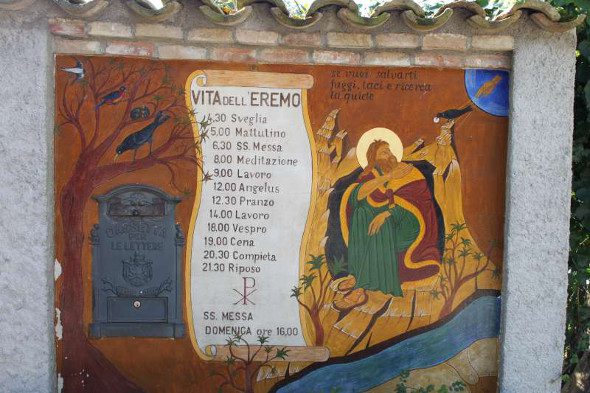Il convento, dopo il 1336, a seguito dell’erezione di una torre e di un palazzo fortificato, poteva apparire più una roccaforte che un insediamento religioso. Costruita dai benedettini con materiali recuperati dalle rovine di un tempio pagano dedicato a Marte Ciprio, era un rifugio perfetto per i pellegrini che, stremati dal cammino e dalla fame, la scorgevano da fondo valle e vi trovavano l’accoglienza dei religiosi di Montelabate.
>>Vuoi vedere l’Eremo di San Pietro in Vigneto? Consulta ora le offerte dei migliori hotel nelle vicinanze di Gubbio.
![]()
>> Ci sono offerte in scadenza per agriturismi nella zona di Gubbio! Clicca e consultale subito.
Nello stesso periodo alla chiesa si aggiunge, prima l’ospedale per pellegrini, poi le strutture residenziali appartenenti a monaci benedettini. C’è una particolare continuità costruttiva con l’edificio originario tanto che è difficile distinguere e identificare i singoli edifici. Solo il campanile a vela e una minuscola monofora a sesto fanno intuire la presenza della cappella nell’angolo nord-est del complesso. Per il resto, la chiesa, che all’interno conserva affreschi del XV secolo, si confonde totalmente con le altre strutture. Non lontano dalla chiesa, sono stati rinvenuti frammenti di manufatti lapidei antichi, scoperti nel XVIII secolo, che testimoniano la preesistenza di un tempietto pagano.
>>Se hai deciso di vedere l’Eremo di San Pietro in Vigneto ti consigliamo di contattare ora gli hotel nelle vicinanze di Gubbio>> clicca questo link.
The convent, after 1336, following the building of a tower and a fortified edifice, could appear more as a fortress rather than a religious settlement.
In the same period is added to the church, first the hospital for pilgrims, and then the residential apartment structures belonging to the Benedictine monks. There a particular building continuity with the original edifice, so that it is difficult to distinguish and identify the single edifices. Only the belfry and a very small one hole arched window make us guess the presence of the chapel in the north-east corner of the complex.
For the rest, the church, which inside preserves the frescoes of the 15th century, totally confounds itself with the other structures. Not far away from the church, have been found fragments of antique rock works, discovered during the 18th century, which testify of the pre-existence of a small pagan temple.
The convent, after 1336, following the building of a tower and a fortified edifice, could appear more as a fortress rather than a religious settlement.
In the same period is added to the church, first the hospital for pilgrims, and then the residential apartment structures belonging to the Benedictine monks. There a particular building continuity with the original edifice, so that it is difficult to distinguish and identify the single edifices. Only the belfry and a very small one hole arched window make us guess the presence of the chapel in the north-east corner of the complex.
For the rest, the church, which inside preserves the frescoes of the 15th century, totally confounds itself with the other structures. Not far away from the church, have been found fragments of antique rock works, discovered during the 18th century, which testify of the pre-existence of a small pagan temple.
The convent, after 1336, following the building of a tower and a fortified edifice, could appear more as a fortress rather than a religious settlement.
In the same period is added to the church, first the hospital for pilgrims, and then the residential apartment structures belonging to the Benedictine monks. There a particular building continuity with the original edifice, so that it is difficult to distinguish and identify the single edifices. Only the belfry and a very small one hole arched window make us guess the presence of the chapel in the north-east corner of the complex.
For the rest, the church, which inside preserves the frescoes of the 15th century, totally confounds itself with the other structures. Not far away from the church, have been found fragments of antique rock works, discovered during the 18th century, which testify of the pre-existence of a small pagan temple.
The convent, after 1336, following the building of a tower and a fortified edifice, could appear more as a fortress rather than a religious settlement.
In the same period is added to the church, first the hospital for pilgrims, and then the residential apartment structures belonging to the Benedictine monks. There a particular building continuity with the original edifice, so that it is difficult to distinguish and identify the single edifices. Only the belfry and a very small one hole arched window make us guess the presence of the chapel in the north-east corner of the complex.
For the rest, the church, which inside preserves the frescoes of the 15th century, totally confounds itself with the other structures. Not far away from the church, have been found fragments of antique rock works, discovered during the 18th century, which testify of the pre-existence of a small pagan temple.



Comment (0)